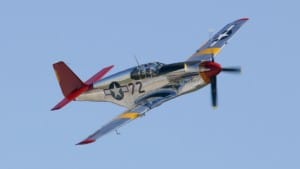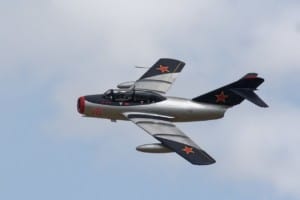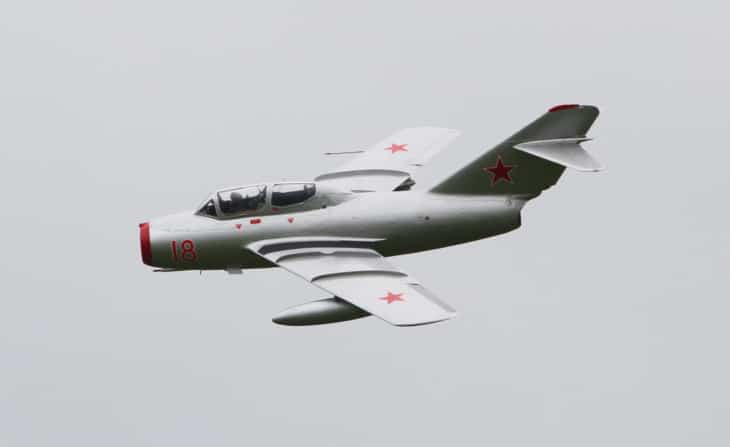Undoubtedly, the P-51 Mustang was one of the most impressive fighters of World War II. But what about its Soviet counterpart, the MiG 15? How does it compare?
Some say the MiG 15 was a better aircraft – more agile and faster than the P-51. Others claim that the Mustang was a more formidable opponent, with a better range and heavier payload.
So which fighter was superior? Let’s take a closer look at the two aircraft and see what we can learn.
| Aircraft: | North American P-51 Mustang | Mikoyan-Gurevich MiG-15 |
|---|---|---|
| Photo: |
 |
 |
| Country: | United States | Russia |
| Manufactured: | from: 1940 to: 1945 | from: 1947 to: 1954 |
| ICAO: | P51 | MiG-15 |
| Price: | $0.59 million | $ million |
| Avionics: | - | - |
| Engine: | 1x Packard (Rolls Royce) V-1650-7 Merlin | 1x Klimov VK-1 |
| Engine Type: | Piston | Jet |
| Power: | 1,720 horsepower | 6,000 horsepower |
| Max Cruise Speed: |
383 knots 709 Km/h |
598 knots 1,107 Km/h |
| Approach Speed (Vref): | 87 knots | - |
| Travel Range: |
1,434 Nautical Miles
2,656 Kilometers |
1,360 Nautical Miles
2,519 Kilometers |
| Fuel Economy: | - | - |
| Service Ceiling: | 41,900 feet | 50,800 feet |
| Rate of Climb: |
3200 feet / minute 16.26metre / second |
10080 feet / minute 51.21metre / second |
| Take Off Distance: |
366 metre 1,200.77 feet |
- |
| Landing Distance: |
457 metre 1,499.33 feet |
- |
| Max Take Off Weight: |
5,490 Kg 12,103 lbs |
6,106 Kg 13,461 lbs |
| Max Landing Weight: |
5,490 Kg 12,103 lbs |
- |
| Max Payload: |
910 Kg 2,006 lbs |
1,363 Kg 3,005 lbs |
| Fuel Tank Capacity: |
269 gallon 1,018 litre |
380 gallon 1,438 litre |
| Baggage Volume: | - | - |
| Seats - Economy: | 1 seats | 1 seats |
| Seats - Business Class: | - | - |
| Seats - First Class: | - | - |
| Cabin Height: | - | - |
| Cabin Width: | - | - |
| Cabin Length: | - | - |
| Exterior Length: |
9.8 metre 32.15 feet |
10.1 metre 33.14 feet |
| Tail Height: | 4.08 metre - 13.39 feet | 3.7 metre - 12.14 feet |
| Fuselage Diameter: |
0.9 metre 2.95 feet |
1.35 metre 4.43 feet |
| Wing Span / Rotor Diameter: |
11.28 metre 37.01 feet |
10.1 metre 33.14 feet |
| Wing Tips: | No Winglets | No Winglets |
| More Info: | North American P-51 Mustang | Mikoyan-Gurevich MiG-15 |
|
Data presented is for entertainment purposes and should not be used operationally.
|
Other North American P-51 Mustang comparisons:
- Nakajima Ki-84 vs P-51 Mustang
- P-51 vs Me 262
- P-51 Mustang vs Spitfire
- P-38 Lightning vs P-51 Mustang
- P-51 Mustang vs F4U Corsair
- P-51 Mustang vs P-47 Thunderbolt
- P-40 Warhawk vs P-51 Mustang
- F6F Hellcat vs P-51 Mustang
- P-51 Mustang vs Bf-109
- P-51 Mustang vs A6M Zero
Other Mikoyan-Gurevich MiG-15 comparisons:
About the P-51 Mustang

The P-51 Mustang, manufactured by North American Aviation, was first flown in 1940 and quickly became a crucial player in World War II. It was utilized as a fighter and bomber, with more than 15,000 units produced during the war.
One of its unique features was its versatility regarding engines. While it was initially designed with an American Allison engine, later versions were outfitted with British Rolls-Royce Merlin engines – leading to improved performance at high altitudes. This proved especially valuable during missions over Germany.
The P-51 also played a significant role in the Korean War and continued being used by air forces worldwide until the 1980s. Its sleek design and impressive capabilities allowed it to stand the test of time and solidify its place in history as one of the most significant fighter planes ever made.
Why was the P-51 developed and built?
The P-51 Mustang was developed and built in response to the need for an effective bomber escort during WWII. The Mustang utilized a standard, reliable engine and had extra internal space for a more significant fuel load.
This enabled it to accompany bombers on long-range missions, with the added option of external fuel tanks for even longer flights.
The Mustang proved successful in this role, leading to the production of over 15,000 aircraft. Variants such as the A-36 and F-82 Twin Mustang were also developed, utilizing the same basic design. The P-51’s effectiveness as a bomber escort ultimately helped turn the tide of the war in favor of allied forces.
What purpose did the P-51 serve?
There are several reasons why the P-51 Mustang is often considered one of the most significant fighter planes ever made. First and foremost, it was an incredibly versatile aircraft.
It could be used for various roles, including air-to-air combat, air-to-ground attack, reconnaissance, and even as a long-range escort for bombers.
Additionally, the P-51 was effective at high and low altitudes, making it a formidable opponent for enemy aircraft. It also had a good range and could be outfitted with external fuel tanks for extended missions.
About the MiG 15

The MiG-15 was powered by one of the most powerful jet engines available at the time, the Soviet-built VK-1. Its swept-back wings and streamlined fuselage allowed for incredible speed and maneuverability in combat.
The MiG-15 was armed with one 23 mm and one 37 mm cannon and optional rocket pods or bombs.
In addition to its use during the Korean War, the MiG-15 saw action with Soviet and Warsaw Pact forces during the 1956 Hungarian Revolution and various nations during conflicts in the Middle East and Africa in the 1960s.
However, perhaps its biggest claim to fame was as a symbol of technological achievement in the Cold War arms race: In 1960, an American pilot named Francis Gary Powers was famously ejected from his U2 spy plane after a MiG-15 shot it down over Soviet airspace.
The MiG-15 remained in service until the 1970s, with some versions still used today by a handful of countries. Even after retirement from frontline combat duty, it continues to be popular among collectors and nostalgists for its sleek elegance as one of history’s most iconic fighter jets.
Why was the MiG 15 developed and built?
The MiG 15 was developed and built during the Cold War in response to intelligence reports of American B-29 bombers flying high above Soviet airspace. As jet engines became more advanced and efficient, the Soviet Union recognized the need for a fighter aircraft capable of intercepting these high-flying enemy bombers.
To achieve this, the MiG 15 utilized two powerful early jet engines as well as swept wing technology, both advancements borrowed from captured German aircraft from WWII.
The success of the MiG 15 in combat against American fighters during the Korean War cemented its reputation as a formidable opponent, quickly gaining favor among Soviet pilots. American engineers eventually reverse-engineered it and produced it domestically as the F-86 Sabre jet.
What purpose did the MiG 15 serve?
There are several reasons why the MiG-15 is often considered one of the most significant fighter planes ever made. First and foremost, it was an incredibly versatile aircraft.
It could be used for various roles, including air-to-air combat, air-to-ground attack, reconnaissance, and even as a long-range escort for bombers.
How are the P-51 and MiG 15 different?
The P-51 and MiG 15 are both fighter planes that have played significant roles in military history, but they also have substantial differences.
The P-51, also known as the Mustang, was used by the United States during World War II and the Korean War. It was used mainly in escort missions, protecting bombers on their way to the target.
The MiG 15, on the other hand, was a Soviet aircraft primarily used during the Korean War. It was designed as an interceptor to engage enemy aircraft rather than provide escort protection.
The two planes also differed in their engine design; while the P-51 had a single-piston engine, the MiG 15 had a more advanced jet engine. Regarding maneuverability and speed, the MiG 15 had an advantage over the P-51.
However, the P-51’s excellent range and ability to carry heavier payloads made it a formidable adversary in combat.
Overall, while both planes played crucial roles in their respective wars, they were designed with different purposes and had notable distinctions in their capabilities.
How are the P-51 and MiG 15 similar?
The P-51 and MiG 15 are iconic fighter planes from the mid-twentieth century, with formidable reputations for their performance in combat.
Both were developed during World War II, with the P-51 entering service in 1941 and the MiG 15 following shortly after in 1948.
Both planes were powered by a single engine and had a maximum speed of around 600 miles per hour. The P-51 was primarily used by the United States and its allies, while the MiG 15 saw extensive use by Soviet forces during the Korean War.
What’s better about the P-51?
The P-51 has specs that generally make it a more exciting aircraft than the MiG-15. These include:
Engine:
Regarding aircraft engines, the P-51 Mustang’s Rolls-Royce Merlin V-1650 is often considered one of the best. So what sets it apart from other machines? Its unique design allows superchargers to operate at low and high altitudes, giving the P-51 exceptional performance in dogfights and long-range missions.
Additionally, its inline design allowed for a smaller overall engine size while providing 1,490 horsepower. This improved aerodynamics and allowed for additional space within the aircraft. The P-51 carried more fuel and weapons than any other World War II American fighter.
Development:
The P-51 was developed in response to a specific need for long-range escort fighters during World War II. The RAF had been struggling to protect its bombers on long-range missions, and the P-51 was explicitly designed to address this problem. It incorporated several innovative features, such as a laminar flow wing that reduced drag and increased speed and range.
What’s better about the MiG 15?
While the P-51 may have had superior range and payload capacity, the MiG 15 also had several advantages.
These include:
Speed and Maneuverability:
The MiG 15 was powered by a jet engine, which gave it a significant speed advantage over the P-51. It was also more maneuverable, thanks to its lighter weight and smaller size.
Interceptor:
The MiG 15 was designed as an interceptor, which made it better suited for engaging enemy aircraft. It was equipped with air-to-air missiles, a radar system, and other features that made it effective in this role.
Avionics:
The MiG 15 was equipped with a more advanced avionics system than the P-51. This included a better radar system and an autopilot, which made flying more accessible and improved its overall effectiveness in combat.
Conclusion
While both planes had advantages, the P-51 was generally considered more capable. Its superior range, payload capacity, and innovative design made it a better long-range escort fighter. However, the MiG 15 had its advantages, such as speed and maneuverability. In the end, both planes were important in their ways and played crucial roles in their respective wars.


